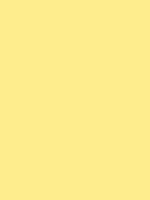#feed8d Color Information
In a RGB color space, hex #feed8d is composed of 99.6% red, 92.9% green and 55.3% blue. Whereas in a CMYK color space, it is composed of 0% cyan, 6.7% magenta, 44.5% yellow and 0.4% black. It has a hue angle of 51 degrees, a saturation of 98.3% and a lightness of 77.5%. #feed8d color hex could be obtained by blending #ffffff with #fddb1b. Closest websafe color is: #ffff99.
-
- R 100
- G 93
- B 55
-
- C 0
- M 7
- Y 44
- K 0
● #feed8d color description : Very soft yellow.
#feed8d Color Conversion
The hexadecimal color #feed8d has RGB values of R:254, G:237, B:141 and CMYK values of C:0, M:0.07, Y:0.44, K:0. Its decimal value is 16706957.
| Hex triplet | feed8d | #feed8d |
|---|---|---|
| RGB Decimal | 254, 237, 141 | rgb(254,237,141) |
| RGB Percent | 99.6, 92.9, 55.3 | rgb(99.6%,92.9%,55.3%) |
| CMYK | 0, 7, 44, 0 | |
| HSL | 51°, 98.3, 77.5 | hsl(51,98.3%,77.5%) |
| HSV (or HSB) | 51°, 44.5, 99.6 | |
| Web Safe | ffff99 | #ffff99 |
| CIE-LAB | 93.261, -6.941, 48.407 |
|---|---|
| XYZ | 75.965, 83.564, 37.326 |
| xyY | 0.386, 0.424, 83.564 |
| CIE-LCH | 93.261, 48.902, 98.16 |
| CIE-LUV | 93.261, 15.722, 64.779 |
| Hunter-Lab | 91.413, -11.639, 39.78 |
| Binary | 11111110, 11101101, 10001101 |
Color Schemes with #feed8d
Alternatives to #feed8d
Below, you can see some colors close to #feed8d. Having a set of related colors can be useful if you need an inspirational alternative to your original color choice.
#feed8d Preview
This text has a font color of #feed8d.
<span style="color:#feed8d;">Text here</span>This paragraph has a background color of #feed8d.
<p style="background-color:#feed8d;">Content here</p>This element has a border color of #feed8d.
<div style="border:1px solid #feed8d;">Content here</div>.text {color:#feed8d;}.background {background-color:#feed8d;}.border {border:1px solid #feed8d;}Shades and Tints of #feed8d
A shade is achieved by adding black to any pure hue, while a tint is created by mixing white to any pure color. In this example, #030200 is the darkest color, while #fffcee is the lightest one.
-
#030200
#030200rgb(3,2,0) -
#161300
#161300rgb(22,19,0) -
#2a2300
#2a2300rgb(42,35,0) -
#3d3401
#3d3401rgb(61,52,1) -
#504401
#504401rgb(80,68,1) -
#645501
#645501rgb(100,85,1) -
#776601
#776601rgb(119,102,1) -
#8b7601
#8b7601rgb(139,118,1) -
#9e8701
#9e8701rgb(158,135,1) -
#b29702
#b29702rgb(178,151,2) -
#c5a802
#c5a802rgb(197,168,2) -
#d9b802
#d9b802rgb(217,184,2) -
#ecc902
#ecc902rgb(236,201,2)
-
#fdd805
#fdd805rgb(253,216,5) -
#fddb18
#fddb18rgb(253,219,24) -
#fdde2c
#fdde2crgb(253,222,44) -
#fde13f
#fde13frgb(253,225,63) -
#fde453
#fde453rgb(253,228,83) -
#fee766
#fee766rgb(254,231,102) -
#feea7a
#feea7argb(254,234,122) -
#feed8d
#feed8drgb(254,237,141) -
#fef0a0
#fef0a0rgb(254,240,160) -
#fef3b4
#fef3b4rgb(254,243,180) -
#fff6c7
#fff6c7rgb(255,246,199) -
#fff9db
#fff9dbrgb(255,249,219) -
#fffcee
#fffceergb(255,252,238)
Tones of #feed8d
A tone is produced by adding gray to any pure hue. In this case, #c9c8c2 is the less saturated color, while #feed8d is the most saturated one.
-
#c9c8c2
#c9c8c2rgb(201,200,194) -
#cdcbbe
#cdcbbergb(205,203,190) -
#d2ceb9
#d2ceb9rgb(210,206,185) -
#d6d1b5
#d6d1b5rgb(214,209,181) -
#dbd4b0
#dbd4b0rgb(219,212,176) -
#dfd7ac
#dfd7acrgb(223,215,172) -
#e3daa8
#e3daa8rgb(227,218,168) -
#e8dea3
#e8dea3rgb(232,222,163) -
#ece19f
#ece19frgb(236,225,159) -
#f1e49a
#f1e49argb(241,228,154) -
#f5e796
#f5e796rgb(245,231,150) -
#faea91
#faea91rgb(250,234,145) -
#feed8d
#feed8drgb(254,237,141)
Color Blindness Simulator
Below, you can see how #feed8d is perceived by people affected by a color vision deficiency. This can be useful if you need to ensure your color combinations are accessible to color-blind users.
